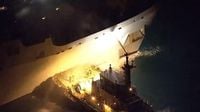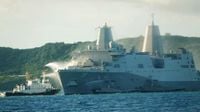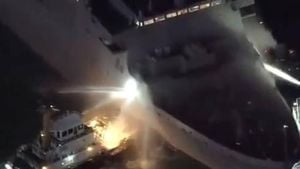On Wednesday, August 20, 2025, a fire erupted aboard the USS New Orleans, a U.S. Navy amphibious transport dock ship, as it floated just off the coast of Okinawa, Japan. The incident, which unfolded near the White Beach Naval Facility, brought swift and coordinated action from both American and Japanese forces. Yet, the event has left lingering questions about safety, preparedness, and the delicate balance of U.S. military operations in the region.
The fire began at approximately 4 p.m., according to the U.S. Navy’s 7th Fleet, and raged for nearly 12 hours before it was finally declared extinguished at 4 a.m. on Thursday, August 21. The USS New Orleans, a 684-foot-long vessel commissioned in 2007 with the capacity to hold up to 800 people, was anchored at the time, its crew suddenly thrust into an emergency that would test their resolve and the effectiveness of international cooperation.
As flames and smoke threatened the ship and its crew, help quickly arrived. The USS San Diego, another amphibious warship specializing in troop and aircraft transport, provided critical firefighting support. Japanese coast guard vessels and military personnel joined the fray, underscoring the close ties and operational coordination between the U.S. and its host nation. Their combined efforts ultimately subdued the blaze, but not before two sailors suffered minor injuries. Both were treated aboard the ship and, according to Navy officials, are expected to make full recoveries.
The cause of the fire remains under investigation by the U.S. Navy’s 7th Fleet. In a statement released after the incident, the Navy confirmed that the crew would remain aboard the USS New Orleans as inquiries continue. For many, the quick response and the relatively minor injuries sustained are a relief, yet the event has reignited concerns about the risks inherent in operating large military vessels so close to civilian populations.
Okinawa Governor Denny Tamaki was quick to voice his concerns. At a press conference on August 21, he expressed regret over the incident, emphasizing the anxiety it caused among local residents. "The fire is extremely regrettable because it caused great fear to Okinawa people and threatened to become a disaster that could have harmed residents," Tamaki stated, urging the U.S. military to implement stronger measures to prevent such events from recurring. His remarks echoed the longstanding unease felt by many in Okinawa, where the presence of U.S. military bases has been a source of both economic benefit and social tension for decades.
The USS New Orleans, with its modern design and considerable capacity, is a symbol of American naval power and technological prowess. Commissioned in 2007, it serves as a vital link in the U.S. Navy’s ability to project force and respond to crises throughout the Asia-Pacific. Yet, as this week’s events demonstrate, even the most advanced vessels are not immune to danger. Fires on ships, while rare, can escalate quickly, threatening lives, equipment, and regional stability.
This latest incident also brings to mind a more catastrophic event from recent memory. In July 2020, a fire broke out aboard the USS Bonhomme Richard while it was docked in San Diego, California. That blaze raged for five days, causing extensive structural, electrical, and mechanical damage. The ship was ultimately scrapped—a sobering reminder of the potential consequences when disaster strikes at sea. According to reports from The Associated Press and Jiji Press, a sailor was charged in connection with the Bonhomme Richard fire but was later acquitted. An official Navy report cited sweeping failures by commanders, crew members, and others involved, highlighting the complexity—and the stakes—of maintaining safety on such vessels.
For the crew of the USS New Orleans, the ordeal was harrowing but, in the end, not tragic. The Navy’s decision to keep the crew aboard the ship suggests a desire to maintain operational continuity and morale, even as investigators comb through the wreckage for clues. The collaborative firefighting efforts, involving both U.S. and Japanese personnel, were a testament to the strength of the alliance and the shared commitment to safety in the region.
Yet, the broader implications are hard to ignore. Okinawa’s strategic location has made it a linchpin of American military operations in East Asia, but it has also placed local communities at the front lines of geopolitical tensions. Incidents like the USS New Orleans fire serve as a stark reminder of the risks that come with hosting foreign military forces. For many Okinawans, the event has rekindled debates about the future of U.S. bases on the island, the adequacy of safety protocols, and the need for greater transparency and accountability.
The U.S. Navy, for its part, has pledged a thorough investigation. The 7th Fleet’s statement emphasized that the cause of the fire is still unknown, and that measures will be taken to prevent similar incidents. In the meantime, the ship remains anchored near White Beach, its crew carrying on with their duties amid the lingering smell of smoke and the memory of a night spent battling flames.
Local media coverage has been extensive, with outlets such as Jiji Press and The Associated Press providing frequent updates and background. The story has resonated not just in Okinawa, but across Japan and the United States, where memories of past naval accidents remain fresh. The specter of the Bonhomme Richard fire looms large, a cautionary tale that underscores the importance of vigilance, training, and international cooperation.
As the investigation unfolds, attention will focus on the root causes of the fire and the steps taken to address any shortcomings. For now, the quick action of the crew and their allies has averted disaster, but the incident remains a sobering reminder of the dangers that accompany military readiness. The people of Okinawa, and indeed the broader region, will be watching closely to see what lessons are learned—and what changes are made—to ensure that history does not repeat itself.
For the sailors of the USS New Orleans and the residents of Okinawa, the events of August 20–21, 2025, will not soon be forgotten. The fire may be out, but the questions—and the calls for accountability—burn on.





